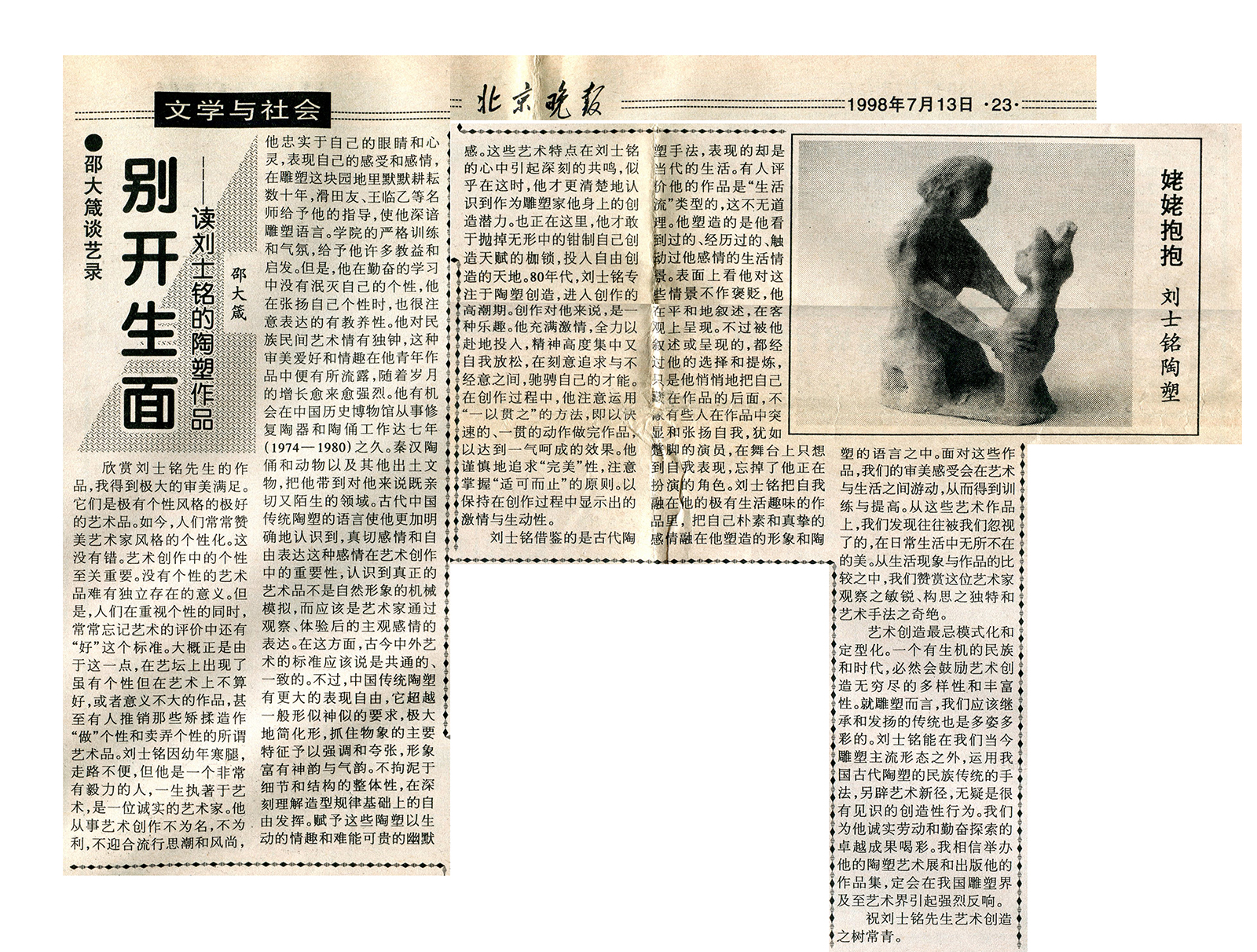
Liu Shiming’s sculptures are of individual unique style in art, and of great value and significance at the same time. Therefore, it always gives me utmost aesthetic pleasure to watch Liu Shiming’s sculptures.
But, however, the individual character in art creation is of vital importance; without one’s individual style, any artwork would be mediocre and would fall short of artistic charm.
However, when people attach importance to individuality, they often, if not always, forget the standards of artistic value and significance in their assessment of artistic works. So it may partly explain why in the realm of arts a large number of works today have strong artistic individuality, but lack value and significance; even there are some people peddling affected individuality as well as showing off his or her individuality of the so called artistic work. Against such backdrop, Liu’s works has brought fresh air so far as the field of arts is concerned.
Liu is an honest artist. He has never created his works for personal fame or interest; nor does he go along with the prevailing artistic trends practice. But, however, he has been working in his own way in this field for decades by being true to his own eyes and mind, and by expressing his own feelings and life experience. Since his childhood he has been under the influence of the folk and traditional Chinese arts, resulting in his strong awareness of arts.
After he entered the Central Academy of Fine Arts, Liu learned the sculptural art under the guidance of veteran artists such as Hua Tianyou and Wang Linyi, and at the same time maintained a keen interest in China’s traditional and folk arts.
Liu was greatly inspired by the training he received and benefited a lot from the active academic atmosphere at the academy. Nevertheless, Liu was always ready to take what he really needed from the academy to hone his skills in plastic art. It seems that Liu drew mainly from his academic education a “refined” way of expression while absorbing nutrition from China’s traditional and folk arts from a new perspective to enrich his own artistic creations.
During his years either as a student or as a lecturer at the academy, Liu made every possible effort to delve into Chinese folk arts, particularly in such fields as local music, local opera, and handcrafts. The seven years of work at the China National Museum of History has made it possible for him to be engaged in the renovation of pottery figures, animals and other ancient relics, ushering him into an unknown but interesting realm.
After studying the traditional idioms of Chinese ceramics and pottery art, Liu came to recognize that it is important for an artist to express his or her own emotions through the art work itself. And it is not the rigged imitations of images in Mother Nature but the artist’s personal observations, experience and subjective feelings that make his or her work a real piece of art.
In this regard, art from all ages and from all over the world share the same criterion. However, to be frank, traditional Chinese sculptural pottery enjoys even more freedom than those made by Western artists. These traditional Chinese pottery figures are rendered with an emphasis on images or spirit that are extremely simplified or exaggerated, often giving the artwork a soul stirring charm beyond verbal expression.
The traditional Chinese pottery figures are full of life and can evoke the viewers a sense of humor. They were done by the ancient artists who paid no attention to the exact details or the wholeness of the visual structure of the subject but worked in a seemingly unstrained manner based on their deep understanding of the subject observed. These artistic features struck the chord in Liu’s heart only at this moment, could he have realized that he himself has much potential for artistic creation.
It was also at this point in his career that Liu had the courage and resolution to shake off the invisible shackles; hence he embarked on a journey of free, artistic creation. If we say that Liu’s early works, such as the 1950 work of “Measuring the Land” and the 1959 piece of “Moving the Mountains and Diverging the River” were tentative works drawing nutrition from folk arts in the academy artistic carvings. Then Liu has chosen a clear and simple way for his artistic creation since the 1980s when China adopted the policy of reform and opening up to the outside world: to embrace the traditional and folk ways of sculpture-making. And it was in the 1980s that Liu devoted himself to ceramic sculpture, and his artistic creation reached a climax.
It is great pleasure for Liu to create artwork; he has been working with passion and devotion; and he brings his talent into full play in intensive pursuit and casual style. In the course of his artistic creation, Liu starts his work with a well-thought-out plan first, then attaches special attention to smoothness and wholeness so as to complete the work at one stretch.
He, with great care, strikes a balance between completeness and perfection, and to maintain moderation or reasonable inadequacy so as to give room for his passion and vitality to grow in his artistic creation.
Liu did learn from ancient sculptures but his works are aimed to show modern life. What he creates is what he sees, experiences, and what moves him. He depicts mariners, farmers, herdsmen, old ladies, little children, bringing to life their dispositions and their inner feelings according to their specific circumstances, but he never depicts them in a negative or degrading manner or depicting them merely out of curiosity.
On surface, Liu usually gives an objective presentation to his subjects. But he does choose what to present to the viewers. But he wisely hides his intentions and true feelings behind the interesting, larger-than-life works done with vivid sculptural language and superb techniques. This makes him stand out from many of his contemporaries who are eager to express themselves through their works just like bad actors, who forget their roles when on stage.
He has never been in pursuit of modernity on purpose, but however, a sense of the time flows out in a natural way through his works.
There is one more thing that needs to be pointed out: Liu’s sculptures are rich in displaying details no matter whether they deal with individuals or groups of people, which are usually no easy job for an sculptor to keep his sculpture from fragmentary.
Liu’s works, no matter whether they depict figures or environment, are characterized by a charm that enchants the viewers sometimes for its exquisite details and sometimes for its brevity and clarity. These works also impress the viewers most with their clear-cut, thought-provoking themes and tones.
The viewers may be entertained and uplifted by these works that bridge ordinary life and artistic creation. Through these works, we would be able to rediscover the beauty of our daily life that we often ignore. In comparison between Liu’s art and images in our daily life, we cannot help but giving applause to the artist for his shrewd observation, unique artistic creation and his remarkable sculptural language.
It is a taboo for artistic creation to become stereotyped and formulated. Diversity and richness in art creation is bound to emerge in China today which is full of vitality.
In the field of sculptural art alone, Chinese artists have made gratifying headway in combining the imported Western sculptural art and traditional Chinese art while taking into consideration China’s social reality.
However, it remains a tough issue for Chinese artists to inherit and revive China’s sculptural tradition in the context of modern society.
It is true that quite a few Chinese sculptors have come to see the urgency of this hefty task and have been making unremitting efforts to change the situation, and to some degree have scored successes. However, it may take quite a long time for Chinese sculptors to change the current situation fundamentally.
Different from the so-called mainstream sculptural art, Liu’s works clearly reflect his deliberate use of ancient Chinese sculptural techniques, a trend setting an example by Liu, a creative artist with vision. We would like to say bravo to his devotion and his brilliant achievements.
And I have a strong faith that the organization of Liu’s art show and the publication of the catalogue for his displayed art works will draw much attention from the sculpture circle and Chinese arts community as well.
May Mr. Liu Shiming keep his artistic creativity as long as long can be!
First draft, June 1998
Final version, July 2006
Final version, July 2006
